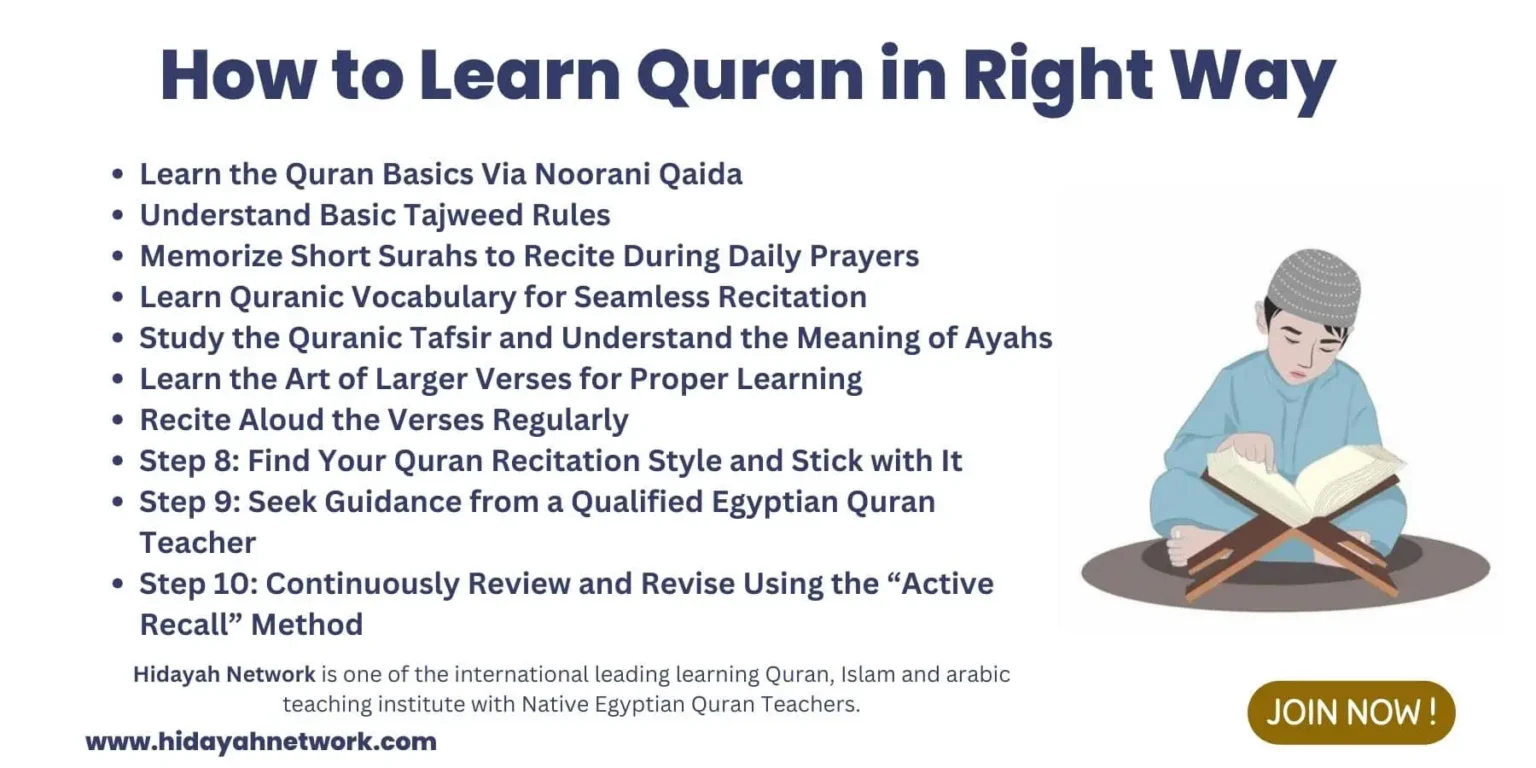How to Learn the Quran?

- Hidayah
- Network
- | Role: Hidayah Network

The journey to learn the Quran can be both enriching and rewarding. This step-by-step guide aims to provide clear direction for beginners seeking to delve into the sacred text. With a focus on simplicity and clarity, this guide breaks down the process into manageable steps, ensuring accessibility for learners of all levels.
From mastering the Arabic alphabet to understanding fundamental Tajweed rules, memorizing short surahs to recite during daily prayers, studying the Quran Tafsir, enrolling in quran hifz course, finding your recitation style, and more, there is a clear pattern that you need to follow. We assure you that when you follow these structured guidelines and commit to regular practice, you can cultivate a deeper understanding and connection with the Quran.
Table of Contents
ToggleStep-by-Step Guide to Learning Quran in Right Way
Step 1. Learn the Quran Basics Via Noorani Qaida
Learning the holy Quran basics via Noorani Qaida involves mastering the Arabic alphabet and basic pronunciation rules. This is crucial because it forms the foundation for reading and reciting the Quran correctly.
Noorani Qaida helps beginners understand the connection between letters and sounds, enabling them to read Arabic text fluently. Additionally, Noorani Qaida introduces basic vocabulary commonly found in the Quran, aiding comprehension, and memorization.
- Arabic alphabet mastery.
- Basic pronunciation rules.
- Understanding letter-sound relationships.
- Learning Tajweed rules.
- Introducing common Quranic vocabulary.
Get 40% OFF Now!
Step 2: Understand Basic Tajweed Rules
Understanding basic types of Tajweed rules involves learning the correct way to pronounce and recite the Quranic text. This is crucial because Tajweed ensures accurate articulation, preserving the integrity of the Quran’s message.
Tajweed rules cover aspects such as the proper pronunciation of letters, elongation of sounds, and rules governing pauses and stops.
- Proper pronunciation of Arabic letters.
- Correct articulation of vowels.
- Rules for elongation (Madd).
- Guidelines for pauses and stops (Waqf).
- Mastery of characteristics of letters (Makharij).
Step 3: Memorize Short Surahs to Recite During Daily Prayers
Memorizing short Surahs involves committing shorter chapters of the holy Quran to memory for recitation during daily prayers. This is crucial as it allows individuals to fulfill the requirement of reciting Quranic verses in their prayers, enhancing spiritual connection and devotion.
Surahs like Al-Fatiha, Al-Ikhlas, Al-Falaq, and An-Nas are commonly memorized for this purpose due to their brevity and significance. Additionally, memorizing these Surahs aids in improving Quranic recitation skills and strengthens the understanding of essential concepts within the Quran.
Step 4: Learn Quranic Vocabulary for Seamless Recitation
Learning Quranic vocabulary involves understanding the meanings of words commonly found in the holy Quran to facilitate smoother recitation and comprehension.
By familiarizing themselves with Quranic vocabulary, individuals can recite with greater fluency and understand the deeper meanings embedded within the verses.
- Understanding the meanings of Arabic words in the Quran.
- Memorizing common Quranic terms and phrases.
- Enhancing comprehension of Quranic verses.
- Facilitating smoother recitation during prayer and study.
- Strengthening the connection to the message of the Quran.
Step 5: Study the Quranic Tafsir and Understand the Meaning of Ayahs
Studying the Quranic Tafsir involves delving into the explanations and interpretations of the Quranic verses to understand their meanings. This is crucial because it provides context, background, and deeper insights into the message of the Quran, aiding in comprehension and application.
By studying Tafsir, learners gain a clearer understanding of the historical, linguistic, and religious contexts surrounding each verse, enriching their engagement with the scripture.
Two very credible Tafsir sources for this purpose are:
- Tafsir al-Jalalayn
- Tafsir Ibn Kathir
Step 6: Learn the Art of Larger Verses for Proper Learning
Learning the art of larger verses entails mastering longer sections of the Quranic text for comprehensive understanding and recitation. This is crucial because longer verses often contain intricate meanings and themes that contribute significantly to the Quran’s message.
By learning longer verses, individuals deepen their engagement with the Quran and strengthen their ability to recite and comprehend its teachings.
To effectively learn longer verses:
- Memorize the starting and ending words of the ayah.
- Understand the meanings and themes conveyed within the ayah.
- Establish connections between the current ayah and adjacent ones.
- Utilize repetition and practice to internalize the ayah’s content.
- Seek guidance from knowledgeable sources or teachers for clarification and deeper insights.
Step 7: Recite Aloud the Verses Regularly
Reciting aloud the Quranic verses regularly involves vocalizing the words and sounds of the Quran during practice and study sessions. This is crucial because it helps reinforce memorization, improve pronunciation, and enhance fluency in recitation.
The Prophet Muhammad (PBUH) says:
“The one who is proficient in the recitation of the Quran will be with the honorable and obedient scribes (angels), and he who recites the Quran and finds it difficult to recite, doing his best to recite it in the best way possible, will have a double reward.” (Sahih Bukhari Riyad as-Salihin 994)
Step 8: Find Your Quran Recitation Style and Stick with It
Finding your Quran recitation style means identifying the way you prefer to recite the Quran and consistently following that approach. This is crucial because each recitation style has its unique melody, rhythm, and pronunciation, allowing individuals to connect with the Quran in a manner that resonates with them.
Seven famous recitation styles are:
- Qirat Naafi’ Al-Madani (Madinah)
- Qirat Ibn Katheer Al-Makki (Makkah)
- Qirat Abu Amr al-Basri (Basra)
- Qirat Ibn Aamir ash-Shami (Syria)
- Qirat Asim Al-Kufi (Kufa)
- Qirat Hamzah al-Kufi (Kufa)
- Qirat Al-Kisaa’i (Kufa)
Pro Tip: To choose a recitation style, individuals can listen to samples of each style, consult knowledgeable sources, and consider personal preference before committing to one for consistent practice and study.
Step 9: Seek Guidance from a Qualified Egyptian Quran Teacher
Seeking guidance from a qualified Egyptian Quran teacher is beneficial because Egyptians are renowned for their expertise in Quranic recitation and Tajweed.
They have a long tradition of Quranic education and are known for their mastery of various recitation styles, making them highly sought after by learners worldwide.
Key features of a Quran tutor include:
- Proficiency in Quranic recitation and Tajweed rules.
- Experience in teaching Quranic studies to students of all levels.
- Ability to provide personalized guidance and feedback to individual learners.
- Knowledge of Arabic language and Quranic interpretation (Tafsir).
- Dedication to fostering a supportive and nurturing learning environment for students.
Step 10: Continuously Review and Revise Using the “Active Recall” Method
The “Active Recall” method is a learning technique that involves actively retrieving information from memory rather than passively reviewing it. This quran memorization method requires learners to actively engage with the material by recalling key concepts, facts, or information without relying on external cues.
To achieve the Active Recall technique effectively, follow these steps:
- Read or study the material thoroughly.
- Close the book or notes and attempt to recall key points or concepts from memory.
- Write down or verbalize what you remember without looking at the material.
- Check your recall accuracy by reviewing the material and correcting any errors.
- Repeat the process of active recall at spaced intervals to reinforce memory retention.
Conclusion
Learning the Quran is a fulfilling journey that requires dedication and commitment. From mastering the basics to seeking guidance from qualified hifz teachers, each step contributes to a deeper connection with the Quran. Remember, consistency and practice are key to success. Hidayah Network is a platform where anyone can learn quran online from home easily. So join now and start your quran learning journey.

About Author
